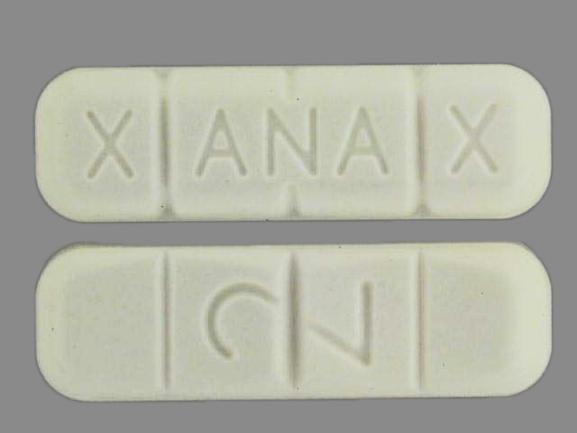Generic Xanax Availability
Last updated on Apr 10, 2025.
See also: Generic Xanax XR
Xanax is a brand name of alprazolam, approved by the FDA in the following formulation(s):
XANAX (alprazolam - tablet;oral)
-
Manufacturer: UPJOHN
Approved Prior to Jan 1, 1982
Strength(s): 0.25MG [RLD] [AB], 0.5MG [RLD] [AB], 1MG [RLD] [AB] -
Manufacturer: UPJOHN
Approval date: November 27, 1985
Strength(s): 2MG [RLD] [AB]
Is there a generic version of Xanax available?
Yes. The following products are equivalent to Xanax:
alprazolam tablet;oral
-
Manufacturer: ACTAVIS ELIZABETH
Approval date: October 31, 1993
Strength(s): 0.25MG [AB], 0.5MG [AB], 1MG [AB], 2MG [AB] -
Manufacturer: AUROBINDO PHARMA
Approval date: July 31, 2015
Strength(s): 0.25MG [AB], 0.5MG [AB], 1MG [AB], 2MG [AB] -
Manufacturer: CHARTWELL RX
Approval date: July 9, 2018
Strength(s): 0.25MG [AB], 0.5MG [AB], 1MG [AB], 2MG [AB] -
Manufacturer: NATCO
Approval date: April 15, 2015
Strength(s): 0.25MG [AB], 0.5MG [AB], 1MG [AB], 2MG [AB] -
Manufacturer: NOVITIUM PHARMA
Approval date: October 19, 1993
Strength(s): 0.25MG [AB], 0.5MG [AB], 1MG [AB], 2MG [AB] -
Manufacturer: SANDOZ
Approval date: December 29, 1995
Strength(s): 0.25MG [AB], 0.5MG [AB], 1MG [AB] -
Manufacturer: SANDOZ
Approval date: March 25, 1998
Strength(s): 2MG [AB] -
Manufacturer: STRIDES PHARMA
Approval date: September 17, 2010
Strength(s): 0.25MG [AB], 0.5MG [AB], 1MG [AB], 2MG [AB] -
Manufacturer: SUN PHARM
Approval date: June 17, 2010
Strength(s): 0.25MG [AB], 0.5MG [AB], 1MG [AB], 2MG [AB]
Note: Fraudulent online pharmacies may attempt to sell an illegal generic version of Xanax. These medications may be counterfeit and potentially unsafe. If you purchase medications online, be sure you are buying from a reputable and valid online pharmacy. Ask your health care provider for advice if you are unsure about the online purchase of any medication.
See also: Generic Drug FAQ.
More about Xanax (alprazolam)
- Check interactions
- Compare alternatives
- Pricing & coupons
- Reviews (916)
- Drug images
- Latest FDA alerts (3)
- Side effects
- Dosage information
- Patient tips
- During pregnancy
- Support group
- Drug class: benzodiazepines
- Breastfeeding
- En español
Patient resources
Other brands
Professional resources
Other brands
Other formulations
Related treatment guides
Glossary
| Term | Definition |
|---|---|
| Drug Patent | A drug patent is assigned by the U.S. Patent and Trademark Office and assigns exclusive legal right to the patent holder to protect the proprietary chemical formulation. The patent assigns exclusive legal right to the inventor or patent holder, and may include entities such as the drug brand name, trademark, product dosage form, ingredient formulation, or manufacturing process A patent usually expires 20 years from the date of filing, but can be variable based on many factors, including development of new formulations of the original chemical, and patent infringement litigation. |
| Drug Exclusivity | Exclusivity is the sole marketing rights granted by the FDA to a manufacturer upon the approval of a drug and may run simultaneously with a patent. Exclusivity periods can run from 180 days to seven years depending upon the circumstance of the exclusivity grant. |
| RLD | A Reference Listed Drug (RLD) is an approved drug product to which new generic versions are compared to show that they are bioequivalent. A drug company seeking approval to market a generic equivalent must refer to the Reference Listed Drug in its Abbreviated New Drug Application (ANDA). By designating a single reference listed drug as the standard to which all generic versions must be shown to be bioequivalent, FDA hopes to avoid possible significant variations among generic drugs and their brand name counterpart. |
| AB | Products meeting necessary bioequivalence requirements. Multisource drug products listed under the same heading (e.g. identical active ingredients, dosage form, and routes of administration) and having the same strength (see Therapeutic Equivalence-Related Terms, Pharmaceutical Equivalents) generally will be coded AB if a study is submitted demonstrating bioequivalence. In certain instances, a number is added to the end of the AB code to make a three character code (e.g. AB1, AB2, AB7). Three-character codes are assigned only in situations when more than one reference listed drug of the same strength has been designated under the same heading. Two or more reference listed drugs are generally selected only when there are at least two potential reference drug products which are not bioequivalent to each other. If a study is submitted that demonstrates bioequivalence to a specific listed drug product, the generic product will be given the same three-character code as the reference listed drug it was compared against. |
Further information
Always consult your healthcare provider to ensure the information displayed on this page applies to your personal circumstances.

